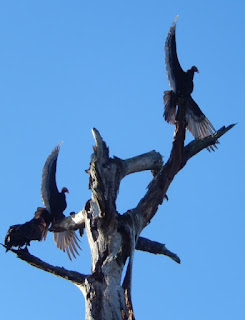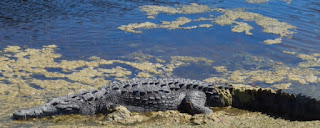Monday, February 27, 2017
In sink land
Having moved to the north central part of Florida, we are in the land of sink holes. At O'Leno State Park the Santa Fe River drops into the ground and makes an exit from the land. The area around the river is filled with sinks which host local wildlife. Nice parks with good paths for both Gary and Blue.
A little rain must fall
But if you are a vulture that means you need to spread your wings to dry off. Yes, they are a little creepy!
Sunday, February 19, 2017
Belated Valentine's Day
For the price one one orchid I have 3 beautiful plants! Happy Valentine's Day to me, now if Blue leaves them alone, I'll be happy. I checked and these are pet friendly.
He might vomit if he eats my plant but that would be because he is a carnivore, not because these are toxic to cats.
Good bye Flamingo
There are many elements that go into making a campground a favorite, nice large sites, part sun part shade, access to water is a great plus and proximity to trails or things to do are all elements we like. Also important for us, Internet, TV and phone. While Flamingo has many of these elements, it is missing the Internet, TV and because of the large number of mosquitos, the trails and outside activity are limited. So this is not on the short list of places we will return to in the future. These pictures are from our last two days at Flamingo when the wind helped out with the bugs.
The first park as you enter the Everglades National Park is Long Pine And it's much better in our opinion. While there is no electric at the sites it is a beautiful park with good services, access to activities and not so remote. Best of all, fewer mosquitos.
In both parks there is the potential for another pest. Draped in black feathers, crows have been know to open hikers backpacks, remove their keys and fly off with the goods. And when the Rangers ask you to keep all food items indoors, these culprits along with the vultures are the reason why. We watched a raid on one tent sites that stripped the missing campers of many food items within minutes. At the Anhinga Trail head you will find blue tarps with bungee cords to place on your vehicle to keep the vultures from removing your windshield wipers and rubber stripping.
Saturday, February 18, 2017
Tree Snails
The living jewels of the hammock, tree snails are a beautiful multicolored inhabitants of southern Florida and the Florida Keys. They are two to three inches long, with color varieties ranging from white to almost black, wrapped in whorls of emerald green, chestnut, orange, yellow or pink.
The tree snail is listed as a species of special concern in Florida. They are threatened by illegal gathering of the shells, pesticides and fall prey to several invasive species that call Florida home.
Friday, February 17, 2017
Anhinga Trail
While many visitors to Everglades National Park stop and hike the Anhinga Trail as their first (and I would suspect for many, their only) glimpse into Everglades National Park, we are making it our exit strategy. Close to the park entrance its a popular and busy place but don't let the flocks of humanity stop you from taking this hike. The wildlife in the park is abundant and the trail an easy trek with many photo ops. I was shocked to hear from more than one person “is that alligator real?” in a heavy western european accent, as their shutters clatter and children reach out to touch the tail of a seven footer along the path. Wow, I understand that many kids today have no idea where their food comes from but I would think they could at least recognize when their tiny fingers are prospective menu items for a gator. I wonder if digits are as tasty to a gator as the deep fried gator bites on-a-stick are to us at the state fair?
The parks namesake
It's getting a little crowded around here, can we please leave the nest now mom?
Nike Missile Site HM-69
It's insane that two men, sitting on opposite sides of the world, should be able to decide to bring an end to civilization - John F. Kennedy, Oct 27, 1962
In the heart of the Everglades National Park sits a well preserved relic of the Cold War. Now a historic site, Nike Hercules Missile Base, HM-69 is much the same as it was when the site ceased to have its military function back in 1979.
When the Cuban Missile Crisis was playing out in 1962, our military scrambled to seal off the perimeter in south Florida. Prior to this event our only exposure to Soviet attack had come from over the North Pole.
In October of 62 the army's 2nd missile battalion and 52nd Air Defense Artillery were deployed to the entrance to the National Park. This location proved to be a poor place to set up a military camp, flooding out with the first rains of the season. In response to the situation the national park managers issued a permit to build a base within the park and HM-69 was born. The base was completed in 1964 immediately following the Cuban Missile Crisis of October 1962. Just 160 miles from the coast of Cuba the anti-aircraft site was strategic in our national security as the Soviet Union built missile sites in Cuba.
In 2004 HM-69 was listed on the National Register of Historic Places and today, we toured the site. A great tour, well worth the time.
Sunday, February 12, 2017
Flamingo Campground Everglades National Park
Named for the beautiful pink birds that once filled the shallow waters at low tide, Flamingo campground now sees only an occasional glimpse of these birds as they fly over. A product of the many changes that have effected the Everglades at the hands of man, these waters are more salient than years past when the waters that flowed through the saw grass provided fresh water to this opening at Florida bay which favored the birds. That has changed and the iconic birds of Florida no longer stop to feed. But the return of the spoon bills (also pink) indicates that the efforts to restore the balance might be working. Notice the one photo of the park visitor center, all in pink with our trusty fold up bikes under the canopy. This is our only connection to the outside universe, also known as the Internet. This is one place that Verizon will not work.
Wednesday, February 8, 2017
Everglades National Park
Flamingo campground
There's no place like home and this national park is it for the next few weeks. We received a warm welcome from the local mosquitos, not as large as the ones back home but they are out all day long, even in the wind! Well good news is we know how to deal with these little pests. The less experienced run around with jackets, long pants, gloves and mosquito netting covering the rest of their exposed flesh. What makes me happy is the 50 amp service given the temps in the mid 80's. Air conditioning is a must when leaving the door and windows shut.
From there it's all good. Part Caribbean and part North America the landscape is unlike any other in the world. Water is the lifeblood of the Everglades. Draining from north of lake Okeechobee via the Kissimee River over a mosaic of marshes, sawgrass prairies, big Cypress swamps and into the Everglades where it empties into the marine estuaries of Florida bay. The Everglades are a fresh water slow moving river of grass that empty into the coastal mangroves where it intermingles with the salt water of the gulf. This barrier stabilizes coastal land while sustaining nurseries for marine life and providing nesting habitat for wading birds. Mangrove forests are the first line of defense against storm winds and surges. 50 miles from no where it pays to think twice before you leave civilization because the resources here are not much. Their are restrooms with showers, a dump station, a small store with junk food and beer, a nice marina and not much more. While checking out the rest rooms for the first time we noticed a posting letting campers know that they need to boil all water before drinking it. We always bring our own thank you!
Shark Valley
As we entered the Everglades National Park our first stop was Shark Valley visitors area. Treating ourselves to the tram tour that runs 15 miles into the swampy saw grasses out to an observation tower was a great choice. We noticed several walkers and bikers that looked fatigued. This is common as most people neglect to bring enough water to stay hydrated, in fact a helicopter landed at the visitor center with emergency crew to check on a women that was having trouble breathing. She refused the flight out and it's easy to understand why when we learned that it costs $10,000 for the trip out!
Our tour guide was well informed and very happy. We learned at the end of the tour that the first row of the tram held his family including parents, wife and baby, all happy to take his tour. Along the road we learned about the Everglades including flora and fauna with several opportunities to see many species of birds and alligators with babies and prospective mates, it is the season when love is in the air if you are a gator.
At the visitors tower we climbed as far as we could for a excellent view of the area. Sightings: great, snowy and cattle egrets; great white, great blue, little blue and tricolor herons; 3 species of ibis; spoonbill; wood stork; purple gallinule; black crowned night herons, a bittern and brown pelicans.
Thursday, February 2, 2017
Barnacle Historic State Park
This little jewel on Biscayne Bay is a great example of old Florida. Ralph Middleton Munroe was the builder and occupant of this beautiful slice of property now sandwiched between two condo's. The last of his family willed it to the state to preserve its historic beauty and to show us what life was like before this became such a sought after piece of real estate. The boathouse was were Monroe designed and built many of the shallow draft yachts used as the primary form of transportation in this shallow bay. The house, originally a one story is named for the shape that resembles the barnacles found on ships in the area and has stood the many hurricanes that hit this area over the last 100 years. He raised the house to create additional living space in 1908. The homes design with a octagonal cupola like structure in its center, helped to move air and cool the house during the hot summers on the bay. Much of the structure was build from salvaged ship wrecks in the bay, another one of Monroe's businesses.
Subscribe to:
Posts (Atom)





















































